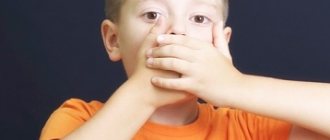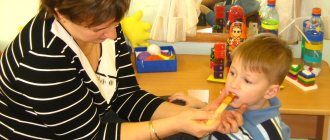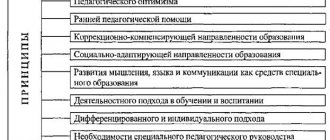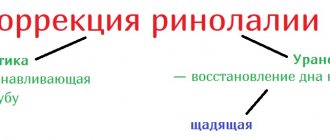Article:
Phonetic - phonemic underdevelopment of speech is a disorder of the sound-pronunciation side of speech in children and adults, caused by underdevelopment of auditory perception with normal biological hearing.
Phonetic-phonemic underdevelopment of speech (hereinafter referred to as FFSD) can be either an independent speech disorder or part of the structure of a defect, for example, in stuttering, aphasia, and is also the cause of poor learning at school. Without good sufficiency of phonemic perception, the formation of its highest level - sound analysis - is impossible. The formation of phonemic analysis and synthesis is an operation of separation and determination of the sequence in the internal plan of the constituent elements (phonemes) of individual sound complexes: syllables and words.
What is FFNR?
Speech is not only the direct reproduction of sound, but also its perception. Hearing and speech apparatus are inextricably linked and one part will not work without the other. Exceptions are possible in adulthood, but a child who has encountered phonetic-phonemic speech underdevelopment in childhood will experience severe difficulties in perceiving phonemes, that is, the primary structures of language.
The longer the FNF is not adjusted, the more severe the consequences may be. Against the backdrop of incorrect perception of information, the child’s socialization is threatened, as is his acquisition of more complex skills such as writing and reading. This is also the first step towards dysgraphia and dyslexia - children who are unable to perceive information by ear begin to transfer their experience to other methods of communication and cognition.
Best articles on the site:
Aphasia – acoustic-gnostic form
Apraxia - causes and symptoms
What games do speech therapists use in their work?
Forms of phonetic-phonemic speech defects
The speech therapy and pedagogical community distinguishes three main stages in the classification of FFN:
- Easy degree. The child's sound perception is not impaired, but only damaged. Only individual sounds are perceived incorrectly; overall, the analysis is at the normal level.
- Average degree. The number of sounds that the child is not able to perceive increases significantly. It differs from heavy speech in that orientation is still present in oral speech.
- Severe degree. The child has a complete violation of the concept of sound sequence - he does not distinguish them, cannot structure them and isolate them separately from the word.
For all three stages of development of the disorder, consultation or observation with a speech therapist is strictly required if the parents do not have specialized knowledge.
Difficulties in pronunciation "r" and r"
One of the common problems of FFN with difficulties with phonemic speech is pronouncing words with the sound “r”. The terms denoting this type of FFN for phonemic difficulties in speech development are rhotacism and pararotacism. Rotacism can be different:
- A child’s tongue vibrates from the side, so it turns out “rl”.
- The lips vibrate when closed and “prr” comes out (this variant of the pronunciation defect is called “coachman”).
- Instead of “r” you hear something similar to the sound “d”. (For example, “rack”, “dose”). This erroneous sound is created when the tongue hits the alveoli with its tip, although it should vibrate.
- The buccal “r” sound occurs when one or both of the baby’s cheeks vibrate. This happens because the air exhaled during pronunciation passes between the molars of the upper jaw and the lateral edge of the tongue.
For such FFN as pararotacism, the following substitutions of the sound “r” are characteristic:
- The baby pronounces the sound “v” with his lips, without vibration.
- The vowels “y” or “i” sound.
- A different sonorant sound “l” is used.
- Words with the sound “g” are born. For example, instead of “joyful” - “disgusting”.
As we noted above, parental laughter in this case will not improve the baby’s speech. This can either cause a desire to continue speaking incorrectly (they say, it’s so much fun for others), or it will irritate the child.
Causes of phonemic underdevelopment of speech in children
A phonetic-phonemic disorder can be either acquired (most often) or congenital - the perception of sounds can be influenced by both external factors, errors in intrauterine development or birth injuries.
Reasons for acquiring FFN:
- Brain injuries. Concussions, just severe bruises - all this can have an impact.
- Long-term infections or viral diseases. A long illness during the first year, while the immune system has not yet been formed, severely traumatizes all systems, including the nervous one.
- Bad heredity - there was someone in the family with similar problems in childhood.
- Severe nervous shocks and chronic stress during the period of active development of the speech system. This is why FFN can often be found in children from disadvantaged families.
Half of the situations are beyond the influence of parents; they can only seek correction in time. However, even among seemingly prosperous families there are children with functional disabilities - it is possible to create a stressful atmosphere of fear, mistrust and anger in any conditions.
Symptoms of phonetic-phonemic speech disorder
The work of a speech therapist begins with diagnosis and, fortunately, small patients with phonetic-phonemic disorders are immediately visible among others. Some symptoms can only be noticed by professionals who conduct tests, and some are noticed by parents themselves.
Main symptoms:
- delay in the development of the nervous system;
- the child’s difficulties with switching attention and, on the contrary, with focusing on something;
- difficulties in pronouncing certain sounds can be traced, there is a system in the child’s mistakes;
- physiological signs such as a “Gothic” high palate and malocclusion, lip structure;
- problems with abstract concepts;
- obvious articulation disorders;
- Possible memory problems.
Basically, a speech therapist understands that he has encountered FFN when he identifies those phonemes that the child does not perceive. If the level of intelligence corresponds to age, as well as vocabulary, there is no doubt.
Features of speech with FFND
With FFNR it is noted:
In addition, characteristic symptoms are:
- replacing or mixing sounds that are similar in phonetic sound;
- insufficient articulation;
- violation of the sequence of sounds and syllables in a word, words in a sentence;
- difficulties in breaking words into syllables;
- errors when changing words by case;
- omissions of syllables, parts of words or whole words (prepositions are often omitted).
Non-verbal symptoms: impaired concentration, increased distractibility, difficulty switching from one activity to another, emotional instability, hyperactivity, poor physical health.
Speech therapy examination for FFN
A speech therapist is the main specialist that such a child will need, but a pediatrician can also diagnose the disorder in consultation with an otolaryngologist. If it is not possible to visit a speech therapist right away, you can safely contact these doctors.
Only a speech therapist can determine the severity of the disease. Upon examination, he will reveal the functionality of the articulatory apparatus and rule out problems with speech for other, more physiological reasons (injuries to the larynx and problems with the respiratory system, for example). The examination consists of a thorough examination of the larynx, studying extracts from other specialists, as well as conducting special tests, based on the results of which it will be possible to accurately judge the FFF.
How to pronounce the sound “r”
To overcome one of the common FFNs - incorrect pronunciation of the sound “r”, a mechanical method is usually used. This is a speech therapy probe.
One of the options for using it is as follows. The child is asked to pronounce two sounds “t” and “zh” together. Just pull out the second sound longer. It should look like “tzhzhzhzhzhzhzhzhzhzhzhzhzhzhzhzhzhzhzhzhzhzhzhzhzh.” At this moment, the specialist inserts a speech therapy probe, at the end of which there is a ball, under the baby’s tongue. The speech therapist, with quick, practiced movements, begins to move the probe from one side to the other.
Other techniques can also be used to solve problems with phonemic speech disorders ffn when pronouncing the sound “r”. For example, through repeated pronunciation of “tdd”, “ddd”, “zzz-a”, “zi” and other combinations of sounds using speech therapy manipulations. Let us immediately emphasize that this should only be done by an experienced specialist with specialized education.
Speech therapy methods for correcting FFN
If the cause of the disorder is determined to be psychological trauma, the child should be observed by a psychologist in parallel with the speech therapist. When speech disorders occur due to psychological trauma, a speech therapist cannot cope alone.
Correction in preschool institutions
It is the preschooler who is easiest to get rid of FFN quickly and “painlessly” for the child himself. For a preschooler, speech functions are very important, but their need cannot be compared with the junior school level, when the performance factor is included.
It is very important for a speech therapist to complete a full course of correction depending on the degree of severity before primary school age, to understand the structure of an individual defect in FFN. For this purpose, speech practice and targeted work with problematic sounds are used.
Speech therapy correction in elementary grades
If a child already has reading or even writing skills (no matter how well), despite his impairment, it is already necessary to work with him differently. The problem is already considered a reading and writing disorder based on phonetic-phonemic underdevelopment.
Since the child now receives much more information, the speech therapist can introduce problematic phonemes into speech in different ways. A younger schoolchild is capable of more serious sound analysis than a preschooler, but the work is still complicated by the need to “adjust” the child to the norms of social development.
Speech therapy work with FFNR children.
Speech therapy work with FFNR children.
CHARACTERISTICS OF CHILDREN WITH PHONETIC-PHONEMATIC UNDERDEVELOPMENT.
A characteristic feature of the phonetic side of the speech of these children is not only the incorrect pronunciation of sounds, but also their rearrangement, substitutions, omissions, which significantly reduces the intelligibility of speech, aggravates its blurriness and indistinctness.
Numerous defects in sound pronunciation:
1) undifferentiated pronunciation of pairs or groups of sounds. In these cases, the same sound can serve as a substitute for 2 or 3 other sounds for the child, for example, soft: the soft sound g is pronounced instead of the sounds s, ch, sh (tyabaka, myatik, tyuba, instead of dog, ball, fur coat);
2) replacing some sounds with others that are simpler in articulation and represent, therefore, less pronunciation difficulty for the child. Usually, sounds that are difficult to pronounce are replaced by easier ones, which are characteristic of the early period of speech development (for example, the sound yog is used instead of the sounds l, l, r, the sound f - instead of the sounds s, w):
3) mixing sounds. This phenomenon is characterized by the unstable use of a number of sounds in different words. In some cases, the child uses the sound correctly, in others, the same sound is replaced by others that are close acoustically or articulatory.
Moreover, the instability of pronunciation increases in the independent speech of children, indicating that such deviations in the formation of pronunciation are associated to a large extent with a lack of phonemic perception. In these cases, children find it difficult to reproduce series of syllables with oppositional sounds, although in isolation these same sounds are pronounced correctly by them (for example, bapa - dad; tadata - datata, etc.).
Mistakes are made when isolating sounds from syllables and words, when determining the presence of a sound in a word, selecting pictures and coming up with words with a certain sound. Children experience difficulties when performing basic tasks related to identifying a stressed sound in a word. Recognition of the first, last consonant in a word, and the syllabic vowel in monosyllabic words is practically inaccessible to them.
All this once again indicates a low level of development of phonemic perception. In general, the complex of described deficiencies in the sphere of pronunciation and perception of sounds in such children gives grounds to classify them as children with phonetic-phonemic underdevelopment (PPI). There are often cases when a child pronounces a given sound correctly in isolation or in words with a simple structure, but in in more complex cases, when oppositional sounds occur simultaneously, mixes them.
Their early identification and targeted training in a special kindergarten allows not only to correct the defect in a timely manner, but also to fully prepare them for school.
An important role in the training and education of children with FFN is played by a clear organization of their life during the period of attending kindergarten. Therefore, the necessary conditions should be created to ensure a variety of active activities for children. The daily routine and the schedule of special classes differ significantly from the generally accepted ones. During the year, children actually study two programs: general education and correctional. Compliance with a certain regime, correct even distribution of the load throughout the day allows you to complete the assigned tasks without unnecessary stress and fatigue.
Simultaneously with the production of sounds, exercises are carried out to distinguish them by ear. The perception of sound stimulates correct pronunciation, and clear, conscious articulation, in turn, contributes to better discrimination of sounds. Therefore, from the very first lessons, children are taught to recognize a sound, even if the child cannot yet pronounce this sound on his own. Concentrating children's attention on the sound side of the language, on the sounds being practiced, fosters activity and awareness of phonemic perception.
In the process of mastering the phonetic side of speech, classes gradually include exercises to teach children to consciously analyze and synthesize the sound composition of a word. Developing the ability to identify sounds from different positions in a word, in turn, helps fill the gaps in phonemic development. A system of exercises to prepare children for learning to read and write begins with identifying the sound in a word and ends with the analysis and synthesis of monosyllabic words.
Educational needs of FFN children.
General needs:
formation of speech behavior and overcoming speech negativism;
normalization of the motor sphere;
correction of speech disorders and optimization of communication skills;
formation of non-speech mental processes, overcoming deficits in cognitive activity;
prevention and correction of sociocultural maladjustment.
Specific needs:
(with early identification of children with speech pathology and the organization of speech therapy assistance at the stage of detecting signs of deviant psycho-speech development; systematic correctional and speech therapy assistance in accordance with identified disorders in early or preschool age; receiving mandatory systematic speech therapy assistance in a mass or special type institution )
interaction, coordination of teachers and parents in their close cooperation with specialists in the field of disorders;
possibility of modification and adaptation of the curriculum, variability: interchangeability/reduction/increase of training components, individual thematic sections;
application of individually oriented specific techniques and methods of work;
choosing an individual pace of learning, with a possible change in the timing of advancement in the educational space;
special organization of diagnostic, testing and control-evaluation tools: reducing the volume of control tasks, targeted step-by-step tasks, with more detailed instructions;
objective assessment of the results of students mastering the program;
gentle, health-saving, comfortable mode of training and workload;
the presence of an adapted educational program for children with severe speech impairments, which will determine the content and organization of the educational process at each level of general education;
the need for a concentric approach to the study of educational material, for repeated repetition of the studied material.
The special educational needs of students with physical disabilities determine the specifics of working with such children.
If the child is successfully treated with corrective speech therapy (overcoming violations of the phonetic component of the speech functional system; overcoming phonological deficits; improving the lexico-grammatical structure of speech and coherent speech; prevention and correction of reading and writing disorders), speech pathology can be successfully corrected .
The teacher must undergo professional retraining (advanced training) in the field of inclusive education, study the characteristics of the disorder and the special educational needs of the child, use an individual specialized approach to the child, developing individual assignments, and establish close contact with the student’s parents or accompanying persons.
Planned results of mastering the program.
Senior preschool age (from 5 to 6 years).
Speech development.
The child is sociable and often initiates communication with peers and adults; emotional reactions are adequate and stable, the child is emotionally stable; the child’s passive vocabulary corresponds to the age norm;
a child can show, at the request of an adult, several items or objects related to one concept;
show in the proposed pictures the actions named by the adult; show from pictures objects of a certain geometric shape that have certain properties; understands various forms of inflection;
understands prepositional-case constructions with simple prepositions, diminutive suffixes of nouns, differentiates singular and plural forms of verbs, verbs with prefixes;
understands the meaning of sentences, understands coherent speech well; without errors differentiates both oppositional sounds that are not mixed in pronunciation and those that are mixed in pronunciation;
the level of development of expressive vocabulary corresponds to age; the child accurately names the proposed objects, parts of the body and objects from the pictures;
summarizes the items and objects depicted in the picture; does not make mistakes when naming the actions shown in the pictures;
names primary and shade colors, names the shape of the indicated objects; the level of development of the grammatical structure of speech practically corresponds to the age norm;
the child correctly uses nouns in the nominative case singular and plural, nouns in the oblique cases; plural nouns in the genitive case;
agrees adjectives with singular nouns; uses prepositional case constructions without errors;
agrees the numerals 2 and 5 with nouns; forms nouns with diminutive suffixes and names of baby animals;
the level of development of coherent speech practically corresponds to the age norm; without the help of an adult, retells a short text based on pictures, according to a proposed or collectively drawn up plan;
composes a descriptive story based on a given or collectively drawn up plan; composes a story based on a picture according to a given or collectively drawn up plan;
knows and can recite poetry expressively; does not violate the sound content and syllabic structure of words; breathing volume is sufficient,
The duration of exhalation is normal, voice strength and modulation are normal. The pace and rhythm of speech, pauses are normal. The child uses the main types of intonation; the child repeats syllables with oppositional sounds without errors, identifies the initial stressed vowel from words, he has developed the skills of phonemic analysis and synthesis, syllabic analysis of words, and analysis of simple sentences.
Senior preschool age (from 6 to 7 years old)
the child has good oral language skills,
can express his thoughts and desires, takes initiative in communication, knows how to ask questions, make conclusions, knows and can retell fairy tales, recite poetry, compose stories based on a series of plot pictures or a plot picture, creative stories; he has developed basic skills in sound-syllable analysis of words and sentence analysis, which ensures the formation of the prerequisites for literacy; he has formed a grammatical structure of speech, he knows different methods of word formation;
the child is inquisitive,
inclined to observe, experiment; he has basic knowledge about himself, about the natural and social world, knows how to examine objects in different ways, select a group of objects according to a given characteristic, knows and distinguishes between primary and tinted colors, flat and three-dimensional geometric shapes; the child has formed ideas about professions and work activities; the child is familiar with the composition of a number of units within ten, has the skills of quantitative and ordinal counting; the child has developed skills of orientation in space, on a plane, according to the simplest scheme, plan; the child has ideas about the change of seasons and their order, the change of parts of the day and their order, the order of the days of the week; the child has developed intellectual thinking;
the child is capable of making his own decisions
based on knowledge and skills in various types of activities, the child is able to organize play interaction, master play methods of action, create problem-play situations, master the conventions of play actions, replace objective actions with actions with substitute objects, and then with words, reflect in the game surrounding reality;
the child is proactive and independent
in various types of activities, is able to choose activities and partners for joint activities, the child has developed communication skills, emotional responsiveness to the feelings of others, imitation, creative imagination;
the child is active
interacts successfully with peers and adults; the child has developed a positive attitude towards himself, others, and various activities;
the child is able to adequately express his feelings
, knows how to rejoice in successes and empathize with the failures of others, is able to negotiate, tries to resolve conflicts;
the child has self
-esteem,
a sense of self-confidence;
the child has a developed imagination
, which is implemented in different types of activities;
the child knows how to obey rules and social norms,
capable of volitional efforts, familiar with accepted norms and rules of behavior and ready to comply with them;
The child has developed gross and fine motor skills,
he is mobile and resilient, masters basic movements, can control his movements, knows how to manage them.
Organization of a developing subject-spatial environment.
The subject-developmental environment of the compensatory group provides conditions for the development of a child with functional disabilities in accordance with age characteristics and correctional needs. Game and didactic material corresponds to the age and individual characteristics of the child, it is accessible and sufficient for carrying out correctional and developmental activities: the development of fine motor skills, the formation of speech breathing and phonemic hearing, the enrichment and activation of vocabulary. The educational environment changes in accordance with the lexical theme of the calendar, the content of training, the increasingly complex level of gaming and motor skills, the season, and the age of the child. The group is equipped with aesthetically pleasing modern children's furniture and play centers that have great versatility of use and mobility. All equipment and children's furniture fully comply with safety requirements and SanPiN.
The organization of the educational space in the speech therapist’s office ensures:
- playful, cognitive, research and creative activity of the child, experimenting with materials available to the child;
- motor activity, including the development of large, fine, facial, articulatory motor skills;
emotional well-being and the possibility of self-expression of the child in interaction with the subject-spatial environment.
The organization of the educational space and the variety of materials, equipment and supplies in the speech therapist’s office and group room in accordance with the Program provide:
• playful, educational, research and creative activity of children, experimenting with materials available to children (including sand and water);
motor activity, including the development of large, fine, facial, articulatory motor skills, participation in outdoor games and competitions;
emotional well-being of children in interaction with the subject-spatial environment;
opportunity for children to express themselves.
A properly organized subject-spatial developmental environment in a group room and a speech therapist’s office creates opportunities for the successful elimination of a speech defect, overcoming delays in speech development, allows the child to demonstrate his abilities not only in organized educational activities, but also in free activities, stimulates the development of creative abilities and independence , initiative, helps to establish a sense of self-confidence, and therefore contributes to the comprehensive harmonious development of the individual. The subject-development space is organized in such a way that every child has the opportunity to practice the ability to observe, remember, compare, and achieve a goal under the supervision of an adult and under his non-directive guidance.
The developing subject-spatial environment makes it possible to provide for a balanced alternation of specially organized educational and unregulated activities of children, time for which is provided in the modes of each age group in both the morning and evening periods of time.
The environment created in the group room and the teacher’s office is
speech therapist, balances the emotional background of each child,
promotes his emotional well-being. Emotional richness is one of the important components of the developmental environment. It should be taken into account that the child remembers bright, interesting, unusual things more quickly and easily. The variety and richness of impressions contributes to emotional and intellectual development.
The design of the group uses soft pastel colors; these are the colors of the spectrum that contribute to successful speech development. It is necessary to think through the issue of additional lighting for each working corner, each center.
In the group attended by motorically awkward, poorly coordinated children, special attention is paid to observing the rules for protecting the life and health of children. The group room and office should not be cluttered with furniture; there should be enough space for children to move around; the furniture should be secured; sharp corners and edges of the furniture should be rounded.
The content of the development centers both in the group room and in the speech therapist’s office corresponds to the lexical topic being studied and the lexical topic just completed, which means that every week the content of the development centers is partially updated.
Particular attention is paid to the design of the subject-spatial environment on the walking area. The subject-spatial environment of the walking area should provide opportunities for the development, cognitive, play, and physical activity of children.
Articulation exercises
It is not obvious to an adult how much effort a child needs to put in to pronounce words correctly. This is done not by the power of thought, but with the help of the articulatory apparatus, which in turn consists of several important organs. The concept of correcting phonetic-phonemic underdevelopment would not exist without a general set of exercises that can improve the reproducibility of sounds in most young patients.
For active lip work
Our lips literally shape the sounds we make. The typical and familiar facial movements for us have not yet been imprinted in the child’s memory. He, trying to pronounce sounds, fails precisely because of incorrect positioning of his lips
Effective exercises:
- “Kiss” - the child is taught to stretch out his lips with a tube as if for a kiss. Actually helps with the pronunciation of vowels and sibilants.
- “Smile” - the teeth are closed, and the lips spread into the widest possible smile. Trains facial muscles of the lips. You can alternate with the previous exercise.
- “Piglet” - from the “kissing” position, the child is asked to move his closed lips in a circle, changing the direction of rotation.
For tongue training
The tongue is mostly controlled unconsciously - it rises to the palate in a calm state, and its movements during speech are difficult to distinguish for the average person. It is obvious to a specialist that the tongue is the most important part of the articulatory apparatus and it needs to be trained first.
Useful exercises:
- “Needle” - you need to stick your tongue out as far as possible, but at the same time keep it tense so that there is a sharp tip. It is advisable to hold for up to 10 seconds.
- “Scapula” - the task is also to stick your tongue out as far as possible, but in a relaxed state.
- “Medoc” causes a little difficulty for children, but is very effective. It is necessary to lick the upper lip, but not from bottom to top, but from top to bottom.
- “Tube” - roll your tongue into a tube, straining it. The rounder it is, the better.
Clicking and clicking your tongue also helps - it’s not difficult and children are happy to repeat this exercise at home.
Forecast and methods of prevention of FFN
The main method of prevention is the correct, harmonious emotional education of the child. Either an inexperienced or an indifferent parent may not notice the signs of FFF. If you devote enough time to your child, and even better, take him to a psychologist and speech therapist for preventive examinations, he will not face any acquired disorders.
If there is therapy and speech formation in the child at all stages, FFF will disappear after a few months or six months. The problem is solvable and the baby can be pulled out of any degree.
Related posts:
- What is "War and Peace" about? Summary of the novel “War and Peace” by chapters. All answers...
- Logorhythmic classes and correctional means By various means, speech therapy classes contribute to the effective correction of speech in children...
- Interaction with parents of children with ODD Cooperation with parents of children with ODD - many methods are listed…
- What is folklore and how to use its forms? Small forms of folklore are successfully used in various types of activities for…
Types of activities
The speech therapist takes on children from the senior and preparatory groups. For subgroup lessons, preschoolers are divided into several groups of 3-4 people. The development of the grammatical structure of speech and vocabulary is taken as a selection criterion. The level of children should be approximately the same.
During the lesson, the speech therapist deals with:
- production of sounds;
- automation;
- differentiation;
- vocabulary development;
- grammar;
- auditory perception.
Teachers reinforce the material covered with preschoolers. This may concern both pronunciation skills and lexical topics. Parents also participate in this process, performing special tasks with their children that are given by the speech therapist. In individual lessons, articulation skills and auditory perception are developed. When mastering the correct pronunciation of a sound, the development of the skill of isolating it in a word is involved.
Work with syllable structure is included if necessary. For dysarthria, speech therapy massage is indicated.
The sequence of sound production depends on the individual characteristics of the preschooler. In case of violations of whistling, hissing and sonorous sounds, work is carried out on each group. Sometimes they start with sibilants and sonorants, since these groups require a good air flow and an upper rise of the tip of the tongue.
Frontal classes are conducted with the entire group. They practice lexical topics and differentiation of sounds. At each lesson, a complex of articulatory gymnastics is practiced and the pronunciation of sounds is clarified. The tasks are designed to be completed collectively.










